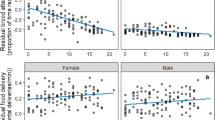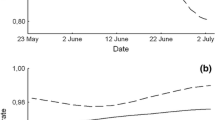Summary
Fostering behavior has been reported in a large number of mammal and bird species although the relative frequency of its occurrence in most species is unknown. A commonly held view is that fostering is costly to the parent(s) engaged in it. However, empirical studies of fostering are few, and measures of either cost or benefit are even rarer. During a study of individually marked Hawaiian monk seal mothers and pups, observed over the course of maternal care, I found that 87% of 30 females fostered pups. Females sequentially fostered an average of 2.3 pups (range: 1–5 pups) during the approximately 40-day lactation. The median proportion of lactation spent fostering was 34% (range: 5%–90%). Confusion during aggressive interactions appeared to be the major antecedent of fostering and may be understandable in terms of the spatial pattern among females. The density of females with pups was relatively low for a land-breeding seal (1.5 females per 1000 m2), and the typical spatial pattern indicated a tendency toward dispersion. Yet, movements of females and pups to and from water occasionally leave females within a meter or two of each other. Several measures of the immediate reproductive cost of fostering were obtained, including: the length of time suckled by pups, the size of pups at the end of suckling, and survivorship to 1 year of age. There was no correlation between these measures for individual pups and the extent to which their mothers fostered, indicating that the high levels of fostering may be maintained in monk seals because they are not selected against.
Similar content being viewed by others
References
Alcorn D (1984) The Hawaiian monk seal on Laysan Island: 1982. US Dep Commer, NOAA Tech Memo NMFS, NOAA-TMNMFS-SWFC-42
Alcorn D, Henderson J (1984) Resumption of nursing in “weaned” Hawaiian monk seal pups. Elepaio 45:11–12
American Society of Mammalogists (1967) Standard measurements of seals. J Mammal 48:459–462
Bartholomew GA (1952) Reproductive and social behavior of the northern elephant seal. Univ Calif Publ Zool 47:369–472
Bartholomew GA (1959) Mother-young relations and the maturation of pup behavior in the Alaskan fur seal. Anim Behav 7:163–171
Boness DJ, James H (1979) Reproductive behaviour of the grey seal (Halichoerus grypus) on Sable Island, Nova Scotia. J Zool (London) 188:477–500
Bowen WD (1990) Behavioral ecology of pinniped neonates. In: Renouf D (eds) Behavior of pinnipeds. Chapman Hall, London (in press)
Burns JJ, Ray GC, Fay FH, Shaughnessy PD (1972) Adoption of a strange pup by the ice-inhabiting harbor seal, Phoca vitulina largha. J Mammal 53:594–598
Carter LR, Spear LB (1986) Costs of adoption in western gulls. Condor 88:253–256
Clark PJ, Evans FC (1954) Distance to nearest neighbor as a measure of spatial relationship in populations. Ecology 35:445–453
Davis RB, Herreid CF, Short HL (1962) Mexican free-tailed bats in Texas. Ecol Monogr 32:311–346
Dinerstein E, Wemmer C, Mishra H (1988) Adoption in greater one-horned rhinoceros (Rhinoceros unicornis). J Mammal 69:813–814
Eales LA, Bullock DJ, Slater PJB (1988) Shared nursing in (Pipistrellus pipistrellus)? J Zool (London) 216:584–587
Eddy WF (1977) A new convex Hull algorithm for planer sets from ACM. Trans Math Software 3:398–403
Erickson AW, Miller LH (1963) Cub adoption in the brown bear. J Mammal 44:584–585
Fogden SCL (1971) Mother-young behaviour at grey seal breeding beaches. J Zool (London) 164:61–92
Gerrodette T (1985) Estimating the 1983 population of Hawaiian monk seals from beach counts. NMFS, SWFC Admin Rpt H-85-5
Gilmartin WG (1983) Recovery plan of the Hawaiian monk seal, Monachus schauinslandi, US Dept Commer, NMFS, NOAAA, Southwest Region
Gilmartin WG (1988) The Hawaiian monk seal: population status and current research. NMFS, SWFC Admin Rpt H-88-17
Graves JA, Whiten A (1980) Adoption of strange chicks by herring gulls, Larus agentatus L. Z Tierphsychol 54:267–278
Gustin MK, McCracken GF (1987) Scent recognition between females and pups in the bat, Tadarida brasiliensis mexicana. Anim Behav 35:13–20
Hebert PN (1988) Adoption behaviour by gulls: a new hypothesis. Ibis 130:216–220
Holley AJF (1981) Naturally arising adoptions in the herring gull. Anim Behav 29:302–303
Holley AJF (1984) Adoption, parent-chick recognition and maladaptation in the herring gull Larus argentatus. Z Tierpsychol 64:9–14
Hunt GL, Hunt MW (1975) Reproductive ecology of the western gull: the importance of nest spacing. Auk 92:270–279
Johanos TC, Henderson JR (1986) Hawaiian monk seal reproduction and injuries on Lisianski Island: 1982. US Dep Commer, NOAA Tech Memo NMFS, NOAA-TM-NMFS-SWFC-64
Johanos TC, Kam AKH (1986) The Hawaiian monk seal on Lisianski Island: 1983. US Dep Commer, NOAA Tech Memo NMFS, NOAA-TM-NMFS-SWFC-58
Johnson BW, Johnson PA (1984) Observation of the Hawaiian monk seal on Laysan Island from 1977 through 1980. US Dep Commer, NOAA Tech Memo NMFS, NOAA-TM-NMFSSWFC-49
Kenyon KW, Rice DW (1959) Life history of the Hawaiian monk seal. Pac Sci 13:215–252
King J (1956) The monk seals (Genus Monachus). Bull Br Mus (Nat Hist) 3:201–256
Kleiman DG (1969) Maternal care, growth rate, and development in the noctule (Nyctalus noctula), pipistrelle (Pipistrellus pipistrellus), and serotine (Eptesicus serotinus) bats. J Zool (London) 157:187–211
Koenig WD (1988) Reciprocal altruism in birds: a critical review. Ethol Sociobiol 9:73–84
Le Bouef BJ, Briggs KT (1977) The cost of living in a seal harem. Mammalia 41:167–195
McCracken GF (1984) Communal nursing in Mexican free-tailed bat maternity colonies. Science 223:1090–1091
Parker GA (1984) Evolutionarily stable strategies. In: Krebs JR, Davies NB (eds) Behavioural ecology, 2nd edn. Blackwell Scientific, Oxford
Petrinovitch L (1974) Individual recognition of pup vocalization by northern elephant seal mothers. Z Tierpsychol 34:308–312
Pierotti R (1980) Spite and altruism in gulls. Am Nat 115:290–300
Plissner JH, Gowaty PA (1988) Evidence of reproductive error in adoption of nestling eastern bluebirds (Sialia sialis). Auk 105:275–278
Renouf D (1985) A demonstration of the ability of the harbor seal Phoca vitulina (L) to discriminate among pup vocalizations. J Exp Mar Biol Ecol 87:41–46
Riedman ML (1982) The evolution of alloparental care and adoption in mammals and birds. Q Rev Biol 57:405–435
Riedman ML, Le Boeuf BJ (1982) Mother-pup separation and adoption in northern elephant seals. Behav Ecol Sociobiol 11:203–215
Rohwer S (1986) Selection for adoption versus infanticide by replacement “mates” in birds. Curr Ornith 3:353–395
Stirling I (1975) Adoptive suckling in pinnipeds. J Aust Mammal Soc 1:389–391
Terhune J, Terhune M, Ronald K (1979) Location and recognition of pups by adult female harp seals. Appl Anim Ethol 5:375–380
Waltz EC (1981) Reciprocal altruism and spite in gulls: a comment. Am Nat 118:588–592
Watkins LC, Shump KA (1981) Behavior of the evening bat Nycticeius humeralis at a nursery roost. Am Midl Nat 105:258–268
Author information
Authors and Affiliations
Rights and permissions
About this article
Cite this article
Boness, D.J. Fostering behavior in Hawaiian monk seals: is there a reproductive cost?. Behav Ecol Sociobiol 27, 113–122 (1990). https://doi.org/10.1007/BF00168454
Received:
Accepted:
Issue Date:
DOI: https://doi.org/10.1007/BF00168454




